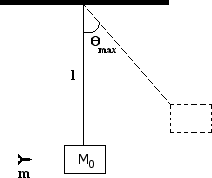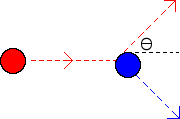Physics Answers
In a laboratory experiment, you wish to determine the initial speed of a dart just after it leaves a dart gun. The dart of mass is fired with the gun very close to a wooden block of mass which hangs from a cord of length and negligible mass as shown below. Assume the size of the block is negligible compared to and the dart is moving horizontally when it hits the left side of the block at its center and becomes embedded in it. The block swings up to a maximum angle from the vertical. Express your answer to the following in terms of , , , , and .

C. The dart is now shot into a block of wood that is fixed in place. The block exerts a force F on the dart that is proportional to the dart's velocity v and in the opposite direction, that is F = -bv, where b is a constant. Derive an expression for the distance L that the dart penetrates into the block in terms of m, , and b.
SOLUTION MISSING: Unfortunately the author of this youtube video removed their content. You may be able to find a similar problem by checking the other problems in this subject. If you want to contribute, leave a comment with the link to your solution.Related Problems
A 2kg car is traveling east at 3 m/s and a 4kg car is traveling west at 6 m/s. Assume the cars collide and stick together. Find the direction and velocity of the cars after they collide.
A 2kg car is traveling east at 3 m/s and a 4kg car is traveling west at 6 m/s. Now assume the cars bounce off each other in a perfectly elastic collision. The final velocity of the 2kg car is -4 m/s. Find the direction and velocity of the other car after the collision.
A champagne bottle of mass 90 g has a 2 g cork in it. The pressure built up in the bottle causes the cork to shoot out, as shown below. If after the explosion, the bottle is moving directly to the left at 4 m/s, what is the velocity of the cork?

The red ball (4 kg) hits the blue ball (5 kg) moving at 2 m/s, and the balls move as shown in the figure below. = 30 degrees. After the impact, the red ball is measured moving at 1.8 m/s. What is the velocity of the blue ball, and at what angle relative to the horizontal is the ball moving after the impact?
